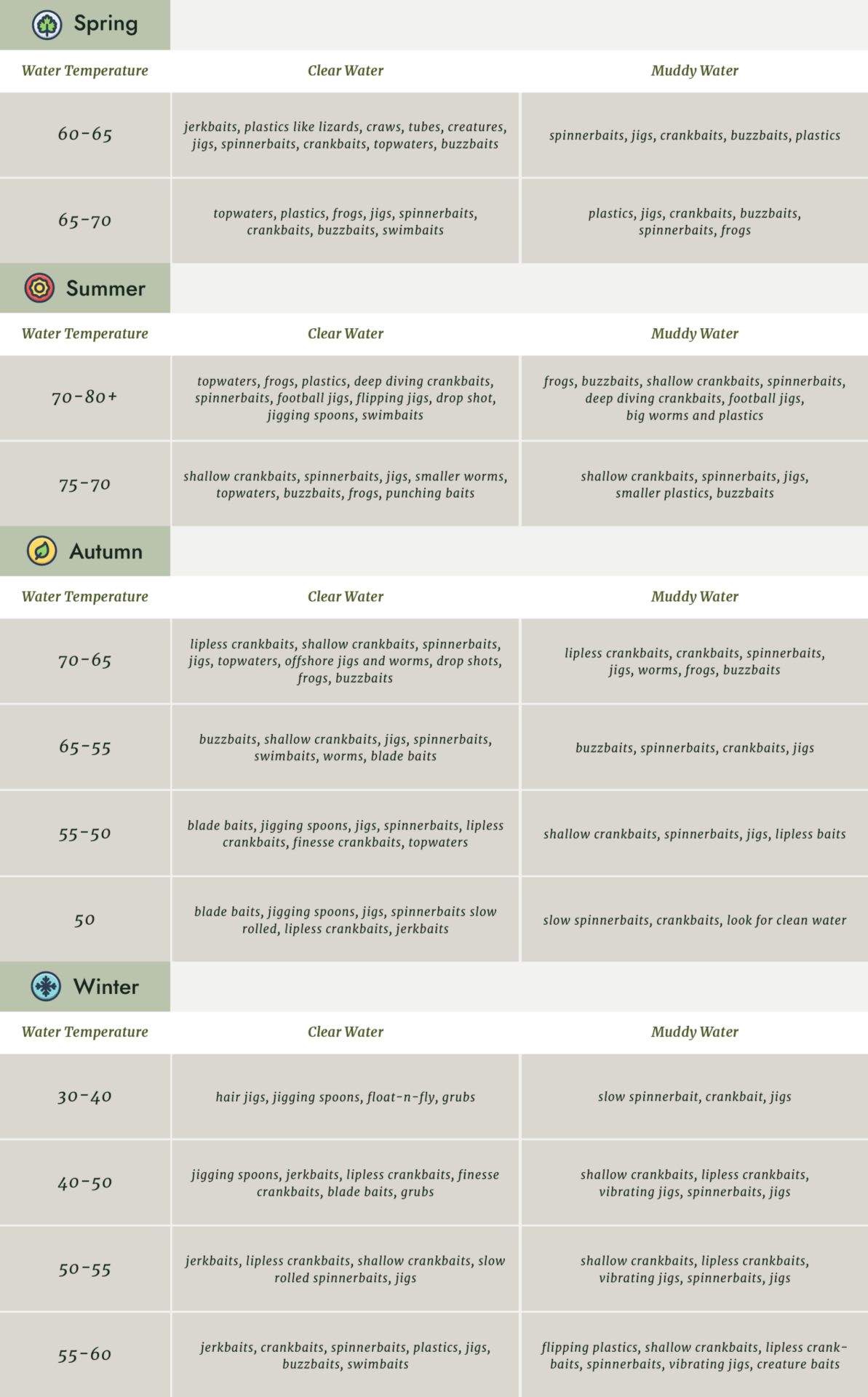
When it comes to catching bass, one of the most important things to consider is water temperature.
Warmer water means active and hungry bass, but how can you tell what the temperature is, and once you know, how can you use that information to your advantage?
Check out our bass fishing water temperature chart to determine the most effective lures and baits for current conditions.
In my experience, using lures suited for the right conditions means more bites and catches.
Table of Contents
What is a Bass Fishing Water Temperature Chart
A water temperature chart, also known as a fish spawning temperature chart, helps anglers use the current conditions on the water and help them select a lure that will be the most beneficial for the temperature.
These charts are based on research that has determined that certain temperatures trigger specific bass behaviors. The charts give anglers an idea of when it’s best to fish in a particular area and when they should move elsewhere.
Using a water temperature chart is straightforward; you just need to know the temperature of the water and look up what lures will help you be the most successful in those conditions.
Most depth finders read the water temperature as well as the depth; however, keeping a small fishing thermometer can be really helpful. That way, you can keep track of the temperature while you fish.
The temperature will change throughout the day, so this will help ensure you know what to presentation and lure is best for the current conditions.
Lastly, when using water temperature charts for bass fishing, it’s important to remember that these charts aren’t set in stone – conditions can change unexpectedly due to weather patterns or other environmental factors.
Using the Right Lures for the Temperature

When the water is at its coldest, often times the less the bait moves, the better.
Bass fishing in water temperatures ranging from 30-40 degrees, jerkbaits, lipless crankbaits and vibrating jigs are going to be your best friends.
When the water is cold, bass become sluggish and conserve energy. This means they are less likely to chase after prey so finesse presentations are generally the ticket to getting a bite.
To increase your chances of landing a bass when the water is cold, you should use lures that move slower or less in the water.
Jerkbaits, lipless crankbaits, spinnerbaits, and swimbaits all create vibrations that attract bass and entice them to strike.
They’re great search baits, meaning they are great for finding the fish, but once you find the fish, you should slow down using finesses presentations, like a drop shot or Ned rig.
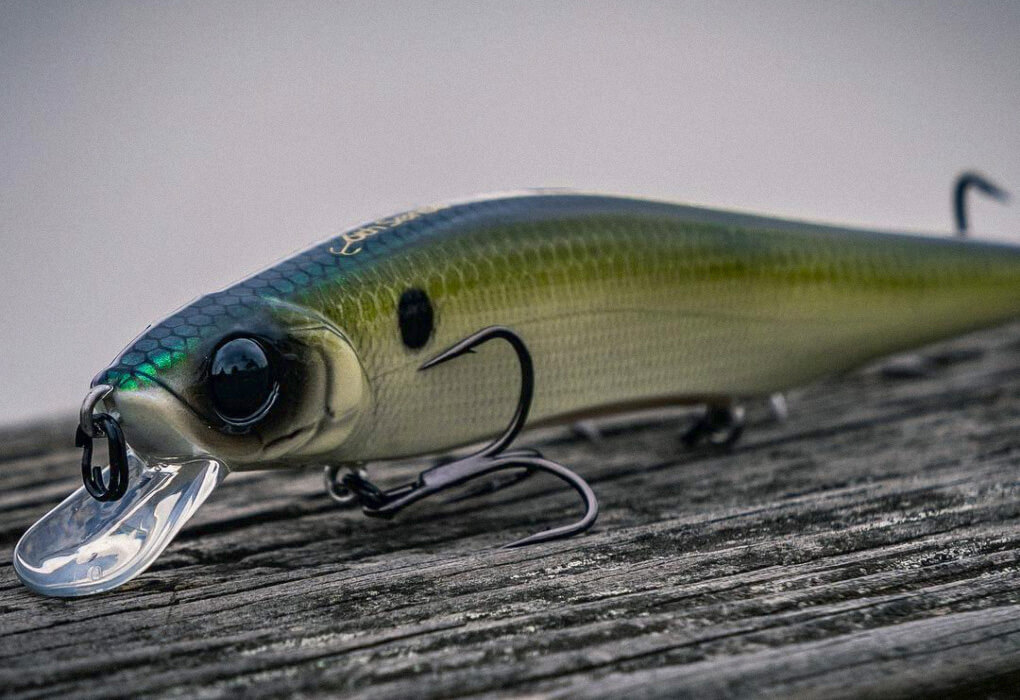
I personally really like using jerkbaits in any weather, but jerkbaits can give an angler an advantage in cold water because their erratic and lifelike movements can entice the fish to take the bait.
Unlike other reaction baits, jerkbaits should be fished more slowly with longer pauses and aggressive rod twitches. This mimics a dying or injured baitfish, and is appealing to bass that aren’t feeding actively due to the cold water.
Jerkbaits do well in deep water around rocks as it helps them get closer to the bottom. So if you’re out on a lake and find a school of suspended bass they’re a good option.
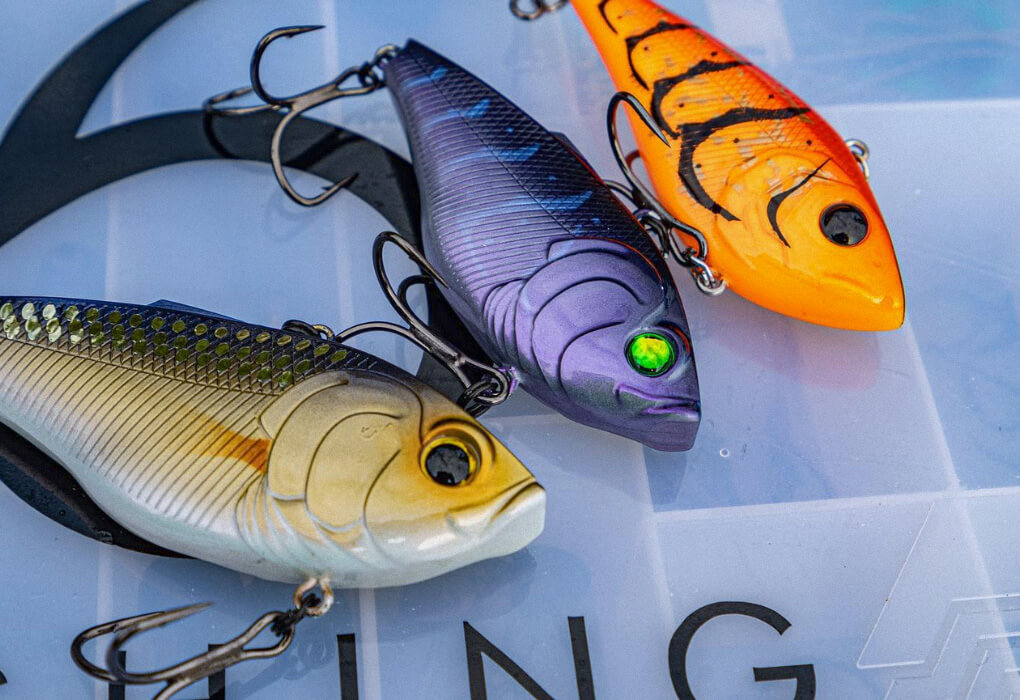
Lipless crankbaits are an effective way to get the attention of bass, thanks to their erratic movement and, in some cases, internal rattle.
They replicate a number of small baitfish, with realistic colors creating an even more appealing presentation.
Lipless crankbaits can be fantastic lures during the cooler months as they can be retrieved shallow or deep and fast or slow.
Pro tip: When shopping for a lipless crankbait take sound into account.
These lures draw attention due to their rattles, so be sure to select one that creates the desired noise levels.
The lure’s action is also essential; how it moves through the water can make all the difference in success. If it’s too erratic it won’t look natural in the cool water, which is why it’s so important to adjust your retrieve speed.
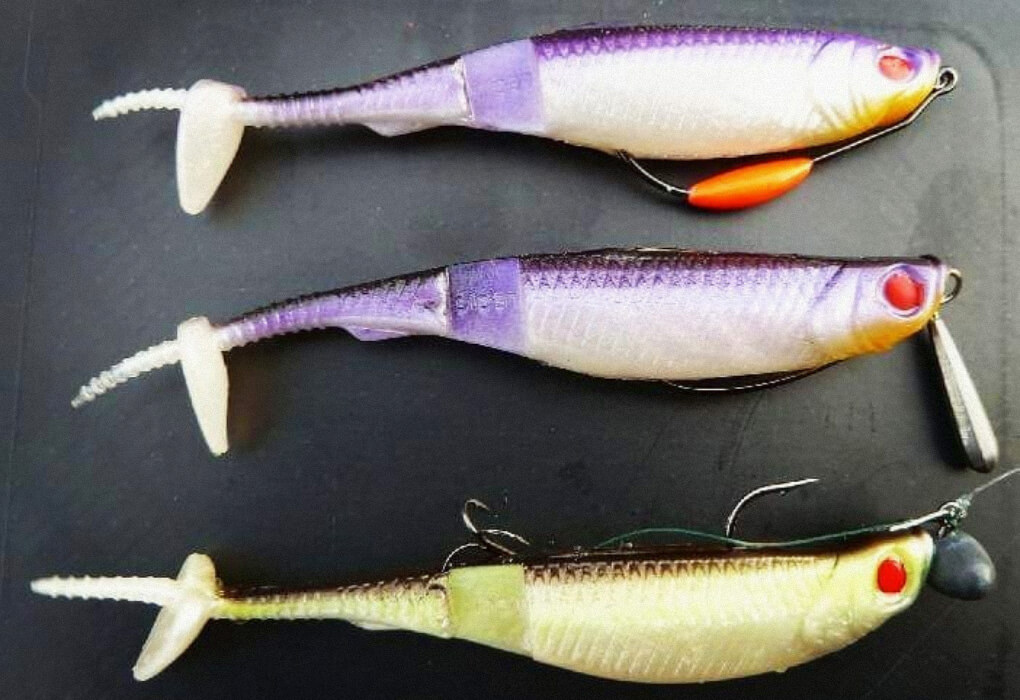
Cold-water bass feed on big baitfish, so swimbaits are a great choice for winter bass fishing. By adjusting your retrieve speed, you can keep it in the strike zone, and faster retrieves work best in shallow water, while slower is better for deeper spots.
One particularly effective technique is to drop shot soft plastics. Drop shotting with soft plastic swimbaits is a great way to target bass in shallow to mid-depth to deeper water, as the bait remains suspended off the bottom.
Any baitfish-colored swimbait is a good choice, and choosing transparent ones will help in cooler water that is clear.
60-70 Degrees Fahrenheit
Generally speaking, in early spring, is when the water temperature range is between 55-70°F, largemouth bass will look for shallow areas to spawn.
Spring is the time for bass to spawn in shallow water, usually when water temperature falls between 55-65°F. When the temperature is between 60-70°F, plastic lures are a great choice.
Try lizards, craws, tubes, creature baits, jigs, spinnerbaits, and crankbaits – any of these will be attractive for hungry bass ready to begin the spawning season.
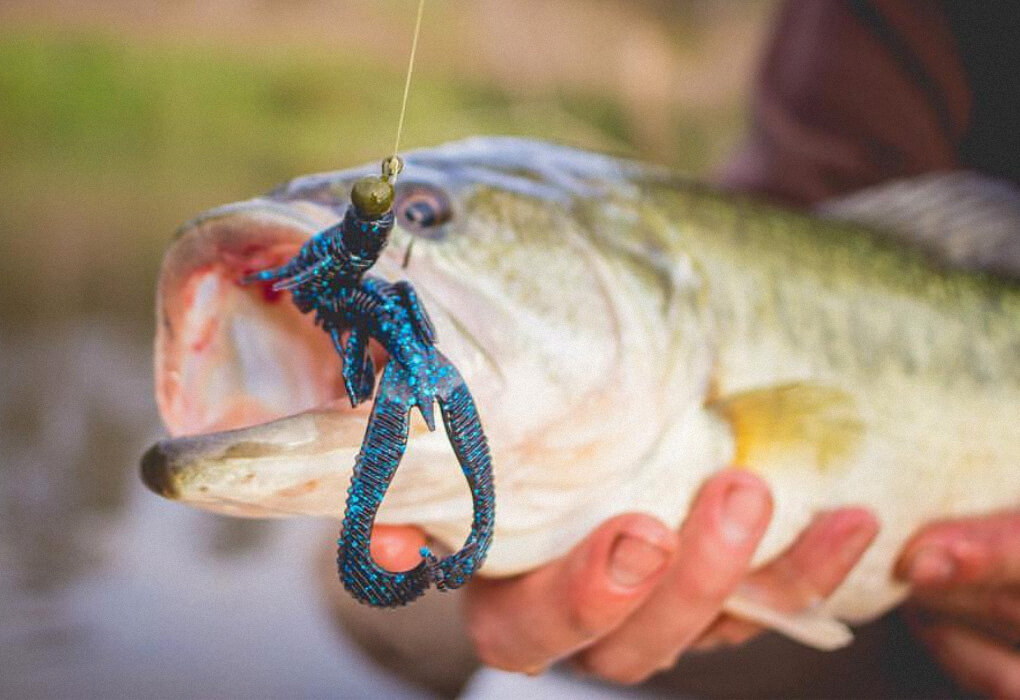
Creature baits like lizards, craws, worms or frogs are a great way to entice bass around shallow cover, which is where they typically are during spring-like temperatures.
Creature baits come in a wide range of colors. Opt for natural, light, and bright hues like white, orange, or greenpmpkin in clear water. If the water is murky, go for black and blue or red.
When it comes to shapes and sizes, big beaver tail baits are great for big bass because of their bulky profile. But small creature baits get bites, too, so don’t be discouraged if that’s all you have to use while fishing.
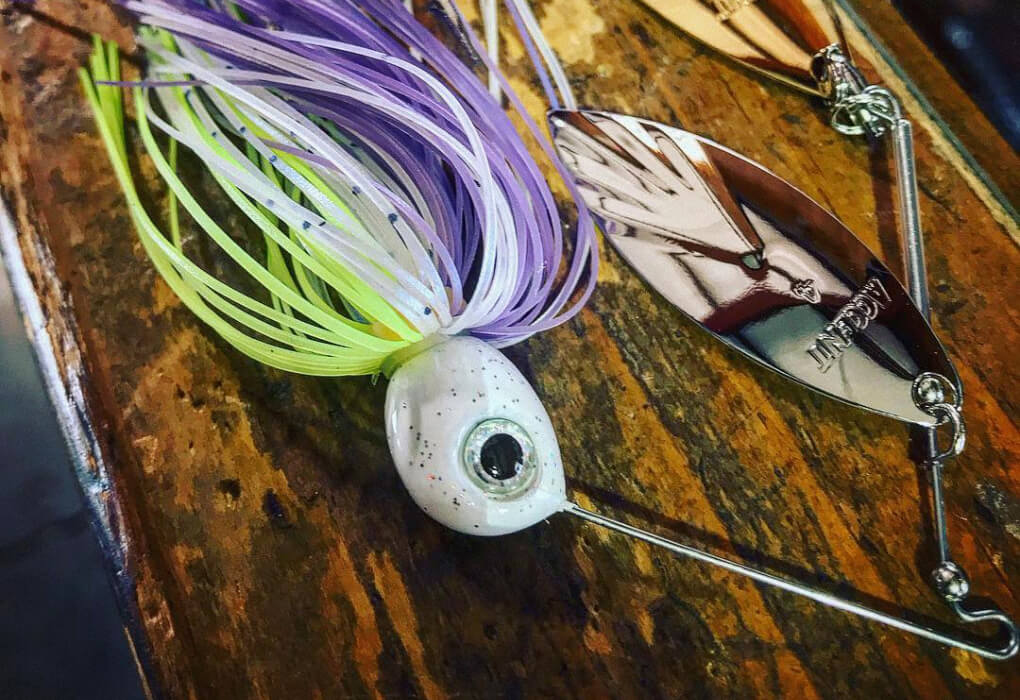
When bass fishing in the spring season, spinnerbaits are a great option due to their versatility and ability to draw strikes from big bass.
Black is an ideal color for this time of year since it stands out against most backgrounds, allowing for easy visibility.
A quality spinnerbait should have one or two spinning blades, a jig head and a skirt over the hook, I’ve found keeping it all dark color will produce the most catches, regardless of water clarity.
70 – 80+ Degrees Fahrenheit
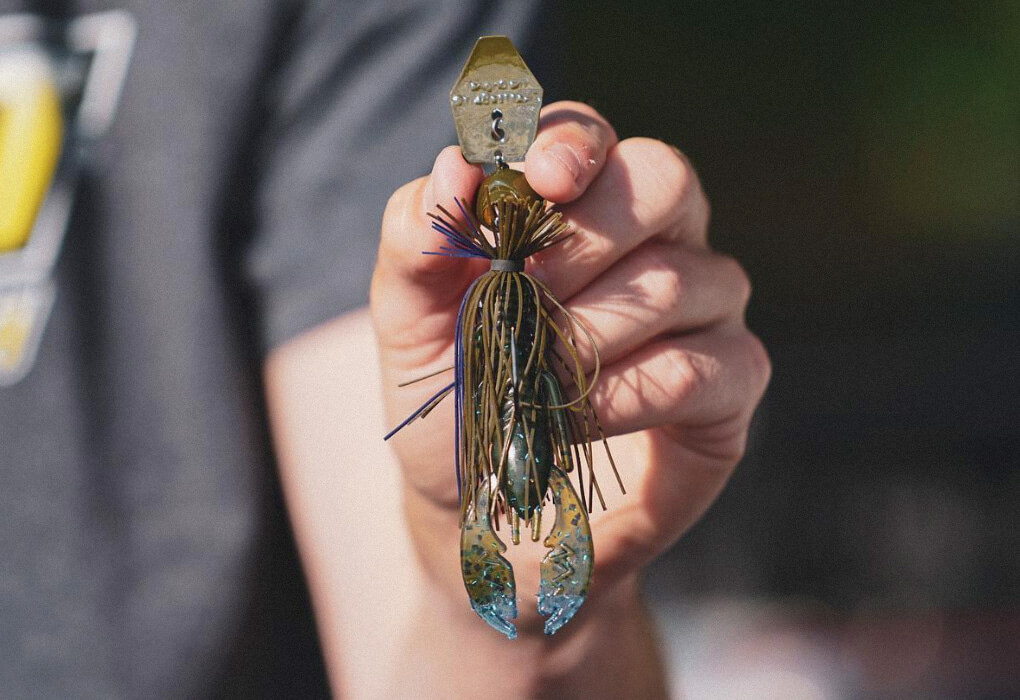
Chatterbaits are a great way to target bass when the water temperature is getting warm.
However, these lures are most effective when there is choppy or murky water and less so in clear water.
During the summer months, Chatterbaits can be especially successful around various types of cover such as grass mats, logs, laydowns, and docks; areas where bass tend to either hide from the heat or look for food.
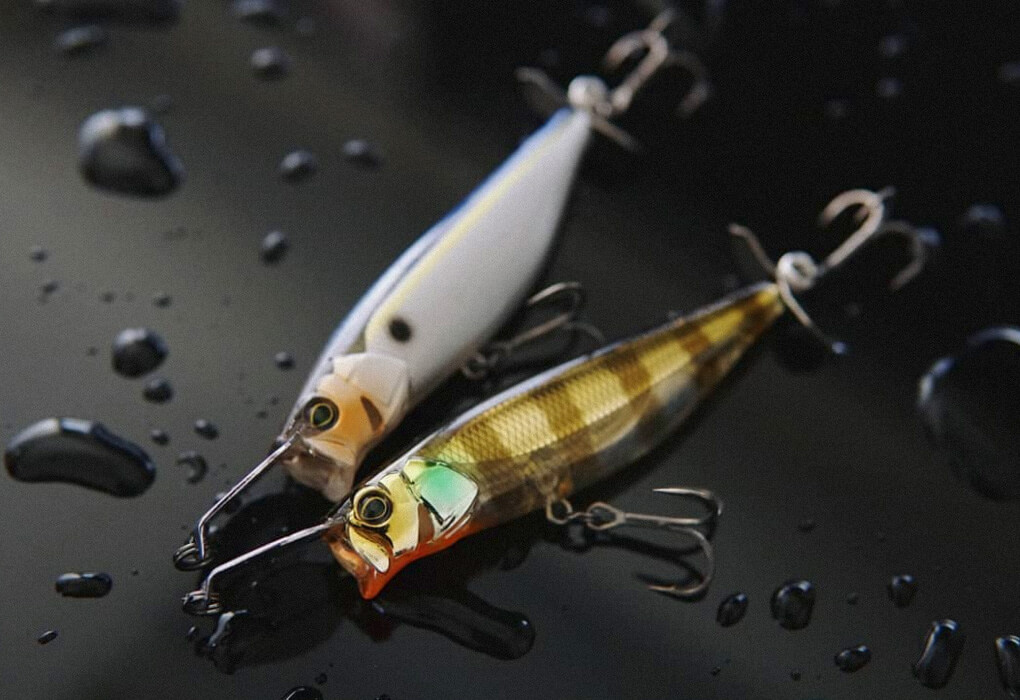
In warm water, topwater baits are the go-to for catching bass. Their surface disturbance and splashy display of movement attracts predators looking for an easy meal.
Topwaters are best used when the water temperature is over 55 degrees as they provide a realistic representation of baitfish on the surface.
The key to success is having the right kind of lure: one that both catches attention and can cut through vegetation underwater.
For this, you need a lure with enough action to draw in predators, as well as strong construction to prevent getting hung up in the weeds. Overall, the Smithwick Devil’s Horse will get the job done well.

Crankbaits are a great way to lure big bass, especially during the early summer. They can dive deep or shallow, bump off rocks, or quickly move through thick cover.
To make your crankbait more appealing, add some ‘twitch’ or movement to your line to give it an erratic motion that will surely get the attention of hungry fish.
There are a few different types of crankbaits to use during the summer.
A squarebill crankbait works best in shallow water, while a deep diving crankbait works best in water 15-25 feet deep.
Frequently Asked Questions
Does Air Temperature Affect Water Temperature?
Yes, air temperature affects water temperature when bass fishing. In general, the air temperature will be higher than the water temperature; however, if there is a cold front or the air is unusually cold you may find that the water temperatures are warmer than the air temperature.
How do you catch bass in 80 degree water?
To catch bass in 80 degree water, look for spots that provide shade and shelter, such as logs, rocks, weeds, docks or other structures. To maximize your chance of catching fish in these conditions, use lures like jigs and crankbaits that mimic the movements of their prey.
What water temperature does Largemouth bass prefer?
Largemouth bass prefer temperatures of 82-84°F and smallmouth prefer a couple degrees cooler.
Final Thoughts
Knowing the water temperature is key to being a successful bass fisherman, which is why utilizing a bass fishing water temperature chart is essential.
By doing so, you will be able to better understand what lures and baits to use in order to easily catch fish.
Now that you know how important it is to use a bass fishing water temperature chart, be sure to download our cheatsheet for more information on other helpful fishing tips!
And if you have any questions, feel free to leave us a comment below.




